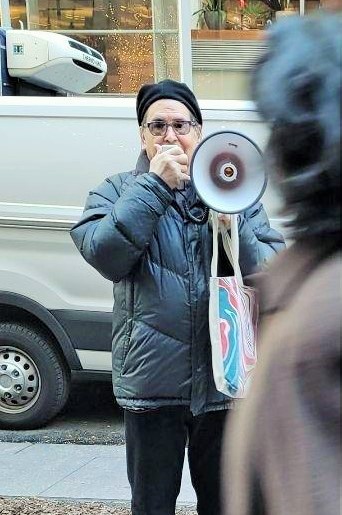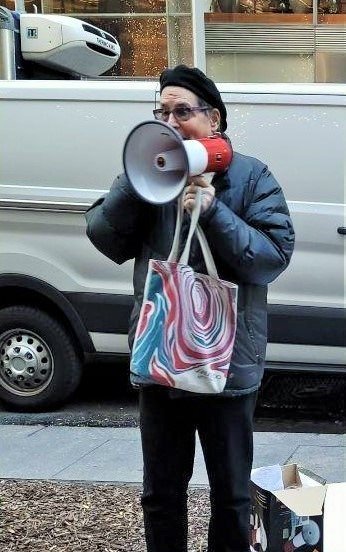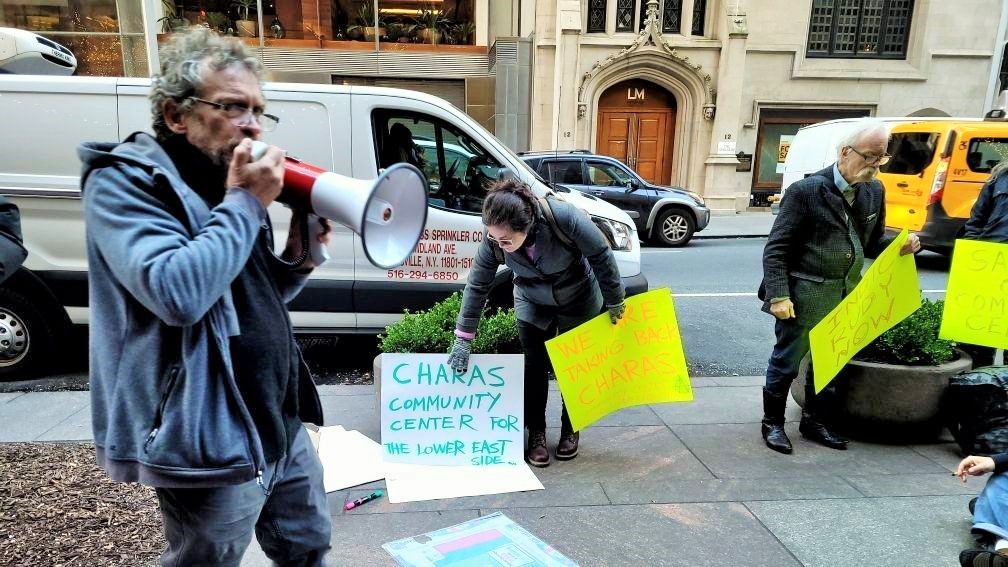BY THE VILLAGE SUN | The Loisaida East Side Guardians (formerly Guardians of CHARAS) took their direct-action campaign north of 14th Street on Monday, protesting outside the Midtown offices of Madison Capital Realty.
The rally’s theme was “Hey Billionaires! Give Us Back Our Community Center!”
Led by former East Village squatters Frank Morales and Ken Toglia, the Guardians say they are protecting the old P.S. 64, at 605 E. Ninth St., at Avenue B, from arson and other possible threats. The historic, through-block building, after sitting vacant under a developer’s control for more than 20 years, has slipped into foreclosure, with lender Madison Capital Realty poised to seize control of the property. However, preexisting lawsuits are reportedly slowing down the transfer of ownership.
A crowd of about 30 showed up for Monday’s protest at Madison Avenue and 53rd Street. The high-powered real estate investment firm says it specializes in “unique opportunities in innovative growth markets.”
In addition to Madison Capital, the Guardians also demonstrated at a Corcoran real estate office nearby. Corcoran bizarrely has the old school listed for sale as an 89-unit “pre-war co-op,” despite a deed restriction limiting its use to “community facilities,” such as, for example, schools, medical offices, dorms or social-service day centers.

“Over all,” Toglia said, “our message is caveat emptor. Whoever is interested in buying it needs to know they’re buying a real headache. We want Madison to open a dialogue with the city. We want Corcoran to take it off their roles. We want Rudy to apologize for selling it.
“And let’s just say we are prepared to escalate our tactics,” Toglia added. “How can people claim it’s impossible to save CHARAS by seizing it, if that’s how CHARAS was started?”
Morales previously told The Village Sun there were several times he wanted to occupy the building, including when developer Gregg Singer was evicting CHARAS. But Morales said, in the end, he always deferred to CHARAS, Inc., as well the group Save Our Community Center CHARAS 64 (SOCCC64), both of which opposed the tactic.
Until the city auctioned the decommissioned former school in 1998, the property was home to CHARAS/El Bohio, a thriving, Puerto Rican-led cultural and community center. Singer, who purchased the building at auction for $3.12 million, evicted CHARAS — which had initially squatted it — at the end of 2001. However, faced by a united front of opposition from community activists, local politicians and City Hall, all of Singer’s plans for the building — early versions of which called for demolishing it and replacing it with a high-rise university dorm — have come to naught. Singer is currently suing the city for “tortious” (wrongful) interference.

After Monday’s protest, the Guardians went to the WABC Radio studios to do an interview, where they, ironically, just missed bumping into Rudy Giuliani. It was under the former mayor that the decision was made to auction the old P.S. 64. Morales saw Giuliani in with Curtis Sliwa, the Guardian Angels founder, who has a talk show on the station.
The Giuliani administration did not like CHARAS because the East Village group, including notably one of its co-directors — the late District Leader Armando Perez — was a bitter political foe of then-Councilmember Antonio Pagan. A Giuliani ally, Pagan eventually landed a plum job in the mayor’s administration.
Also angering Randy Mastro, one of Giuliani’s deputy mayors, CHARAS allowed Latin Kings gang members to hang out inside the city-owned building and fill out job applications, on the grounds that police were said to have been hassling them in Tompkins Square Park. The founders of CHARAS themselves were former gang members who had turned over a new leaf to embrace community empowerment.
In addition to changing the group’s name, Toglia recently said the Guardians were no longer going to refer to what he called “the CHARAS site” as CHARAS anymore but as “the future home of the East Ninth Street Community Center, or E9CC.” CHARAS, Inc., had objected to the use of the Guardians of CHARAS name and also the likeness of its executive director, Chino Garcia, in an Uncle Sam-like “Uncle Chino” poster created by a friend of Toglia’s, R.J. Kikuchiyo.
As previously reported by The Village Sun, Garcia is now accusing Morales of “taking advantage” of the double whammy of Garcia being laid up in a rehab facility while the building is simultaneously in foreclosure. SOCCC64 and the board of CHARAS, Inc., of which Garcia is the president, say the situation with negotiations to try to recover the building is very delicate and fear the Guardians will disrupt it.
For their part, Toglia and Morales say they just want to help at a critical juncture for the building, the community and Garcia and that things should not be “behind closed doors” but out in plain view, and that the full power of the community should be harnessed for the effort.


Yeah! What Cary said!
The restoration of CHARAS as a community center is a keystone for shaping the future of Alphabet City as a sustainable, bohemian enclave and prototype Green City Retrofit.
There is enough space in the old P.S. 64 building to ultimately let a variety of idealistic projects go ahead. A tendency to some degree of infighting, personality conflicts and factionalization is regrettably common among activist groups, but such is par for the course throughout movements for social change. That tendency should be downplayed and socially discouraged so as to avoid self-sabotaging a worthy cause. The extraordinary potential of the site itself is what has sparked my imagination. I hope everyone involved will try to stay focused on the realization that we have a chance to do something really special here, and let the strengths of the ideas themselves hold sway. The youthful energy of the Ravers and graffiti artists could be channeled in positive ways if there was a vibrant center of creative activity in the neighborhood, much like Bucky Fuller showed us was possible with an earlier generation in the 1970s.
The return of the CHARAS building to community activists in Manhattan’s last surviving, authentic bohemian district could let us create a hip new NYC tourist attraction, much like Christiania in Copenhagen combined with the Rock and Roll Hall of Fame in Cleveland, the American Visionary Art Museum in Baltimore, and the underground art installations of Damanhur in Italy, featuring as its centerpiece a museum of bohemian subcultures and an ecotopian education center that will give youth the historical perspective, knowledge and practical skills to let them leapfrog from the best legacy of past generations. By having these “shoulders to stand upon,” becoming familiar with approaches their predecessors have tried, seeing what worked well and pitfalls to avoid, Generation Z bohemians can become the first to finally reach what our collegiate peers could only glimpse when we too dreamed of actualizing an Earth-friendly, free-spirited, information-rich lifestyle. Enhanced with relevant features, Alphabet City can be promoted as a demonstration model for a prototype Green City Retrofit aimed at inspiring a new wave of practical, utopian experimentation in the 2020s, featuring comprehensive technological and cultural innovation.
With this topic prominent in the news, joining forces on a local project designed to focus attention on solution-oriented approaches to the Climate Crisis could earn a lot of favorable publicity and potential funding. Jeff Bezos alone has pledged $10 billion to fighting climate change. James Cameron founded the Avatar Alliance Foundation in New York and is about to have several very good years. There is big money out there in philanthropic foundations with a relevant mandate.
In his recent book, Bill Gates has alerted us: “As the global population rises, urban areas around the world are booming, and that means more and more buildings are going up. By one estimate, the world will add 2 trillion square feet of buildings by 2060 — the equivalent of putting up another New York City every month for the next 40 years.”
What sort of cities do we want these countries emulating? What features do these cities need in order to foster human potential, ecological harmony and meaningful social community, instead of just desperately warehousing their excess population? Already distinguished and admired for its rare cluster of lovingly tended community gardens on streets near CHARAS and an abundance of bands playing in Tompkins Square Park, Alphabet City can intently become a comprehensive model of what well-planned urban spaces could be like, offering an example to all the world of what to feature in a Green City. Let’s restore this building as a versatile community center and tourist attraction, use it to append innovative facilities for cultural enrichment of the neighborhood, start adding solar panels to local rooftops, intently create a prototype of the ecotopian urban ideal here, and promote it as such.
This long-abandoned but substantial building is large and sturdy enough that — renovated with patronage from creative aristocrats in the entertainment industry, philanthropic tech titans sharing our concerns about Global Warming, and crowdfunding from fans of music groups that went on from playing in local nightclubs to stardom — we could implement and build upon Aton Edwards’s clever and timely idea for developing a world-class Museum of the Counterculture in NYC. Stylishly brought to life here on the Lower East Side, using the latest display technologies and stewarded with an authentic bohemian spirit, that concept has the potential to give Alphabet City a tourist attraction comparable to the Grateful Dead’s original plans for a “Terrapin Station” in San Francisco.
The colorful, multifaceted history of bohemian subcultures and protest movements would surely have the makings of a noteworthy attraction, our galleries able to provide a permanent facility to archive their history in an interactive museum and sensory playground that will bring our younger counterparts up to speed on everything they missed while not born yet or still too young to participate. We can collect oral histories from elders, solicit contributions of books and publications and ephemera from retirees and heirs, archive surviving video footage and audiotape of lectures, digitally scan the photographs and file-cabinet holdings from those long active in the alternative scene to fill out the gaps in what each saved from the heyday of the Beats, Hippies, Punks, New Agers, Neo-Pagans, Sci-Fi Conventioneers, Rainbows, Deadheads, Phishheads, Goths, Ravers, Afrofuturists, Cyberpunks, Radical Faeries, Burning Man, Steampunks, Anime Cosplayers, Faerie Festivals, and other imaginative scenes that are presently consigned to the margins of academic history — plus send crews to document those youth movements and utopian experiments that are yet to come! — establishing a unique resource center and research library conveniently located in the main population center of the northeast USA, telling their story and aiming at engineering the viability, economic proficiency, intergenerational continuity and cross-fertilization of bohemian subcultures. We could invite Interference Archive, which has already amassed an impressive collection focused on movements for social change, to come onboard and give it all a secure, permanent home in a sturdy Public Works Era building.
The Counterculture has long needed substantial facilities like this. The festival scene was economically devastated nationwide by the pandemic shutdown, and much of our history is in danger of being erased entirely as key players face eviction and those who have become elderly pass away. The time to save what remains of this legacy is now.
Similar endeavors in other cities have garnered very substantial public interest: Wikipedia reports that “Christiania is considered to be the fourth largest tourist attraction in Copenhagen, with half a million visitors annually” to its repurposed military facilities transformed into a commune. Wikipedia cites The Rock and Roll Hall of Fame as having attracted 543,000 visitors in 2016 and the American Visionary Art Museum as attracting over 100,000 each year.
I photographed a Latin Kings job fair for a story I worked on with Lincoln Anderson back in the good old days at Charas. I am still calling myself a “Guardian of Charas” and plan to spend May Day, May 1, and my 71st birthday, May 3, there next year.